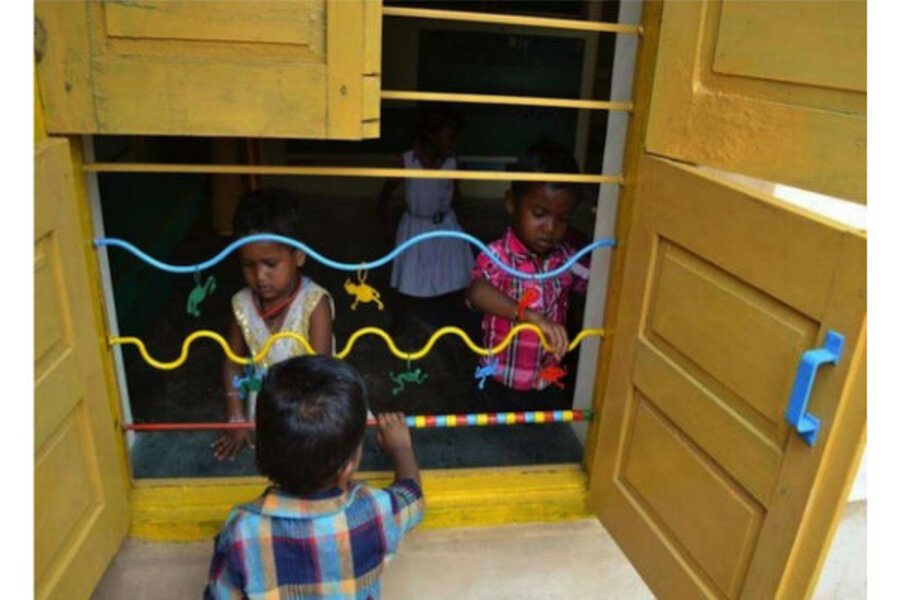Spaces for learning: India enhances creativity by building classrooms without walls
Loading...
The spaces in which we live, work, and play have profound effects on our productivity, creativity, and well-being. For those who can afford the upfront costs of transforming their built environments, this notion has become part of the mainstream.
In the workplace, the design firm Morgan Lovell helps clients such as eBay and Rackspace create spaces to empower employees and enable their businesses to thrive. Practicing what they preach, Morgan Lovell’s own workers enjoy an office in which anyone can work in virtually any space, enjoying a sense of autonomy and flexibility rather than being walled in by cubicles.
In the world of hospitality, luxury hotels are turning to principles of biomimicry, incorporating elements of nature into their buildings. The global design and architecture firm HOK uses energy recovery ventilation, energy-use dashboard displays, and other innovative systems to play up sustainable design and enhance the guest experience at high-end hotels.
Young children, with their impressionable minds and unyielding curiosity, may actually have the most to gain from an engaging built environment. But the traditional school space is divided into rigid domains, with the classroom strictly for learning, the playground for play, and most other spaces built to serve utilitarian purposes.
In response, architect Kabir Vajpeyi seeks to maximize the value of space in India’s schools by creating unified, enabling environments across school grounds, to facilitate a continuous learning process. Vajpeyi’s firm Vinyas, which he co-founded in 1996 with his wife Preeti, has helped spread the methodology of BaLA – Building as Learning Aid – to thousands of preschools and elementary schools across India.
Just as education experts recommend integrating principles of empathy throughout school curricula,the BaLA framework offers guidelines for a holistically enriching built environment that feeds organically into formal instruction. Installing numbers, colors, maps, and units of measurement in a play yard, for example, encourages more peer learning and constructive engagement among schoolchildren, with a corresponding decrease in the incidence of conflicts and fights.
Rather than being confined to a classroom, “the learning is happening across, and is not bounded by time or space. In other words, it lets the children interact with those elements at their own free will,” Mr. Vajpeyi says.
BaLA is designed to spur frugal innovation in both new schools and retrofits through a few broad themes:
Measurement
Vajpeyi advocates incorporating units of measurement – visible markers of distance and angles – throughout the school building and yard to help ground theoretical concepts in reality. He especially likes the idea of labeling pieces of furniture with their weight.
“Children across the world throw furniture, irrespective of where they come from,” he says. “So if we write the weight on furniture, they’ll know that they’ve just thrown a stool that was 5 kilograms or a table that was 20 kilograms. It gives them a sense of measurement.”
Movement
Through BaLA, the built environment should encourage children to move in ways that boost their development. Vajpeyi says many schools have begun transforming the iron bars in their window grills into colorful, undulating shapes that children can trace using small toys. This activity boosts hand-eye coordination and mimics the wrist, arm and shoulder movements required for writing.
Nature
Just as office workers and hotel guests appreciate the incursion of the outdoors into their interior spaces through increased natural light and ventilation, schoolchildren likewise are inherently drawn to nature. In the classroom, BaLA encourages windows be kept curtain-free and placed low to the ground so small children can see outside. In the yard, planted trees have branches low to the ground, encouraging children to climb.
“Loved Spaces”
Just as nature abhors a vacuum, an architect abhors “dead space” in a building that people avoid. BaLA seeks to maximize “loved spaces” that invite children to fill them and accommodate a range of peer group sizes and activities, much as Morgan Lovell strives for offices replete with spaces conducive to working and collaborating.
Such BaLA principles appear at home in Google’s new Bay View, California, campus, which is being constructed as a “frictionless environment,” with spaces connected by a bike track and several landscaped “outdoor rooms” intended for contemplation and creativity.
Projects like Google’s need not be viewed as expensive extravagances inspired by a passing design fad. The proof of effectiveness will come in the form of lower energy costs, higher employee morale, and increased productivity.
The BaLA methodology has been implemented in 30,000 schools, affecting more than 2.5 million children across India, Vajpeyi estimates. Unlike Google, India may never be able to quantitatively measure the economic effects of this shift in design philosophy. But seen up close, the effects of BaLA on children – who become more engaged in their education and more empathetic toward each other – make it seem like a common sense approach to a new generation of built spaces.
This article originally appeared on the Startempathy.org blog, published by the Start Empathy project from Ashoka. This post was written by Dan Schiff, a global project manager for the Ashoka Support Network.





